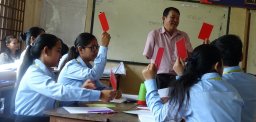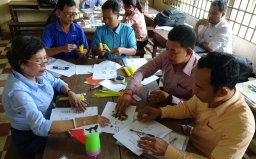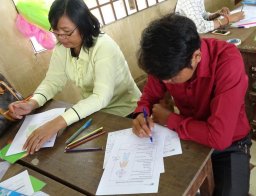
A 5 day-training on Effective Classroom Management and Differentiation
“Groups are too big, with sometimes 11 or 12 pupils in a group, during group work. This leaves many not involved in any discussion. For me, I would use the free space available at the back of the class. Big groups can split into smaller groups and then everyone has a chance to discuss and be active. Another option is that the teacher divides the class into two big groups: one stays inside which is led by one pupil (class monitor) and another one goes outside and is facilitated by the teacher”. Mr Srey Sambun, task force member and teacher trainer from TEC Battambang, points out his view on space management.
Both task force members joined an interactive training ‘effective classroom management’ earlier this year. The training, co-organised by MOEYS and VVOB, was facilitated by trainers Mr Pieterjan Steemans and Ms Nele Depuydt from Karel de Grote Hogeschool (KdG) University College from Belgium. Besides Mrs Sochenda and Mr Sambun 8 classroom management taskforce members, 10 maths taskforce members, 2 directors of Teacher Education Centres (TEC) Phnom Penh and Battambang and VVOB staff joined.
With the learned content and skills on classroom management the task force developed manuals on effective classroom management. They also gained more insight in the different areas of classroom management and increased their confidence in offering training to their target group. Time has moved quickly since that first training. Last month, from 14 to 18 August 2018 the task force members transferred their gained knowledge on classroom management to 80 lecturers of the Teacher Education Colleges in Battambang and Phnom Penh.
Rich training content
- Examples of effective classroom management with a focus on flexible grouping, differentiation, positive discipline, space and time management
- How to use an observation tool to identify the level of pupil’s well-being and involvement
- How to use an observation tool to test to what extent the teacher takes care of differentiation
- Several techniques how to get to know your students well to create a good atmosphere
- Examples of differentiated instructions in teacher training and primary education
- Several techniques of differentiation in STEM activities
- How to integrate differentiation techniques in your lesson plan and try-out it out with student teachers or students
- Case study by experienced teachers who have applied differentiation
- Discussion of video clips on classroom management
The importance of effective classroom management
Educational studies show that good learning outcomes are attained when well-being and involvement are highly ensured. Motivated and effective teachers can, by using a variety of teaching methods, create a stimulating learning environment which leads to a high degree of pupil well-being and involvement. Effective classroom management, implemented by teachers, is absolutely necessary to create a stimulating learning environment. The key components of effective classroom management are: differentiation, flexible grouping, positive discipline, time and space management.
Learning from and through practice
The trainers used active teaching and learning activities, peer-learning and practice during the training. The first training day started with a flexible grouping technique in which participants were divided into groups by using coloured crayons, animal cards, coloured candy and fruit cards. The participants also discussed lesson fragments from real primary school classes in Cambodia. By reflecting on the techniques used by teachers they gained understanding on how to improve pupils’ well-being and involvement. These real-life examples made it very clear how effective classroom management supports pupils’ well-being.
During day 2 and 3 of the training, the participants practiced techniques to get to know their students better. Improved knowledge of your students helps the teacher in using differentiated instructions. Through micro-teaching the participants practiced with a variety of differentiation techniques: supporting slow learners by using differentiated assignments, differentiation in a STEM activity (photo: making a water rocket), inquiry-based lessons using differentiated instruction in primary mathematics and using a science worksheet on living- and non-living things to differentiate students’ abilities.
During the last two training days the participants applied what they learned in the first three days by developing lesson plans and trying out lessons with student teachers. Peer-coaching was organised before and after the try-outs, meaning that lecturers provided each other feedback on their teaching performance.
The participants developed 12 revised lesson plans that incorporate differentiation techniques. These lesson plans will be included in the annex of the classroom management manual that is in development. Target groups such as the lecturers of the TECs and primary school teachers can use them as an inspiration to make their own lesson plans.

This is just the beginning
This August training is only the first in a series of trainings on effective classroom management. The August training had a clear focus on differentiation. The next trainings will focus on the other key elements of effective classroom management: flexible grouping, positive discipline, time and space management.








